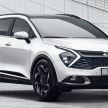Yesterday, Kia pulled the wraps off the new fifth-generation Sportage, which is quite a departure from its handsome Cayenne-lite predecessor to say the least. Naturally, we were quite curious to see how the new car stacks up against its sibling, the Hyundai Tucson, which has also been recently redesigned and will likely be the Kia’s main rival in the marketplace.
Both ride on the Hyundai Motor Group’s latest third-generation platform and feature rather polarising designs, with gaping full-width grilles that take their respective companies’ design languages to new heights. On the Sportage, the black opening is topped by a chrome Tiger Nose graphic that joins the boomerang-shaped daytime running lights, which serve as bookends for the diamond-shaped headlights.
The Tucson, on the other hand, features a tapered design for its Parametric Grille, which incorporates several triangular inserts that are styled to look like jewels. These inserts hide the DRLs that are only visible when they are switched on, with the main headlights now cast off into the corners of the front bumper, forming a cross shape when viewed head-on. Ornate it may have looked when it was first revealed, but next to the Kia, the Hyundai has the cleaner, less fussy front end.
It’s the reverse for the side profiles. Here, the Tucson looks far busier, with a litany of slashes and creases – a styling cue lifted from the Elantra sedan – and angular wheel arches. As for the Sportage, there’s just a single shoulder line running along the doors, plus prominent bulges surrounding the round wheel arches and taut rear haunches that add a bit of muscle.


Both cars also have different approaches to chrome – the Kia has an L-shaped trim piece that wraps around the lower edge of the window graphic, whereas the Hyundai’s brightwork runs along the top of the windows before terminating at the rear windscreen.
Kia and Hyundai’s contrasting design directions continue at the rear. Both the Sportage and Tucson come with full-width taillights that are de rigueur these days, but the former’s lamps appear to be inspired by the Stinger‘s, with “tails” that stretch into the rear fender. The Hyundai’s taillights carry a sharp fang-like design, framing the rear number plate recess. The Kia’s number plate is positioned lower down in the bumper, sitting above an aggressive silver skid plate design.
Inside, the Sportage and Tucson’s futuristic designs again come to the fore, with divergent strategies for each. In the Kia, the dashboard is built around the massive curved display panel, framed by the air vents that stretch the entire width of the cabin. Below them sits a slim touch panel for the climate controls and a tall centre console, on which you’ll find the rotary gear selector and a selection of buttons.
The Hyundai sports a wraparound interior design, with silver lines that flow towards the waterfall centre console. The usual buttons and switches have been dispensed in favour of touch controls and a 10.25-inch infotainment touchscreen, while another 10.25-inch digital instrument display faces the driver. Instead of a dial, the Tucson uses buttons for the gear selector.


Being that the Tucson has been out for longer (it has already gone on sale in certain markets), we know rather more about the toys the Hyundai has on offer. These include an eight-speaker Bose sound system, an upgraded climate control system with an air purifier and a Multi Air mode for diffused airflow, a smartphone digital key and smart home compatibility for controlling appliances remotely.
The Tucson is also packed with the latest driving assistance systems, including autonomous emergency braking, Level 2 semi-autonomous driving capabilities, lane keeping assist, blind spot monitoring and automatic high beam. Expect the Sportage to get all the same functions (and maybe even a few new ones), given that Hyundai and Kia share safety technologies with each other.
No technical details have been revealed for the Sportage just yet, but expect it to also come with the same engines as the Tucson. The Hyundai is offered with a 190 PS/260 Nm 2.5 litre Smartstream naturally-aspirated four-cylinder and a 180 PS/264 Nm 1.6 litre turbocharged mill, the latter also due to be fitted to hybrid and plug-in hybrid models that will produce up to 230 PS and 350 Nm of torque.
So there you have it, the new Kia Sportage and Hyundai Tucson side-by-side. We’ll have more news on the former as we get it, but in the meantime, which one do you prefer? Sound off in the comments after the jump.
GALLERY: 2022 Kia Sportage 



GALLERY: 2022 Hyundai Tucson 








The post 2022 Kia Sportage vs Hyundai Tucson – comparing the polarising designs of Korea’s latest C-segment SUVs appeared first on Paul Tan's Automotive News.



0 Comments